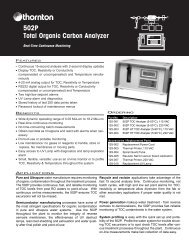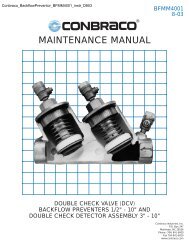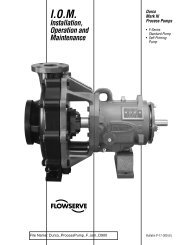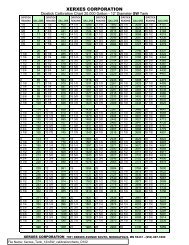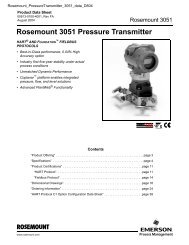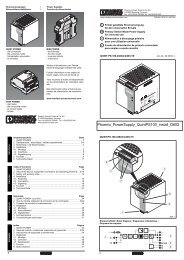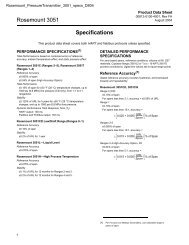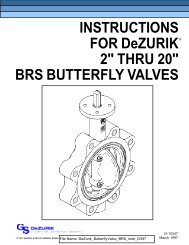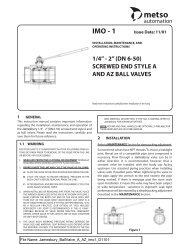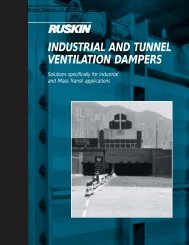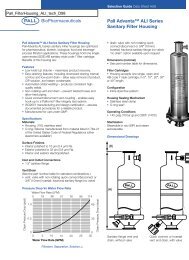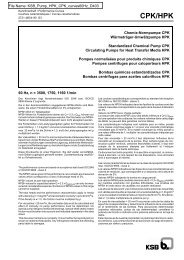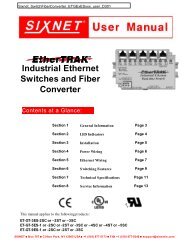You also want an ePaper? Increase the reach of your titles
YUMPU automatically turns print PDFs into web optimized ePapers that Google loves.
* AE14<br />
• Explosion proof for Class I, Division 1, Groups B, C &<br />
D. Dust-ignitionproof for Class II/III, Division 1,<br />
Groups E, F & G.<br />
Temp. Class. T6<br />
Enclosure: Type 4<br />
• Nonincendive for Class I, Division 2, Groups A, B, C<br />
& D; Suitable for Class II, Division 2, Groups E, F &<br />
G; Class III, Division 1.<br />
Temp. Class. T5<br />
Enclosure: Type 4<br />
SAA:<br />
* AE100/200/300MN<br />
SA Certificate No.: AUS Ex 3210X<br />
Type of Protection: Ex dm[ia]IIC T6 IP67<br />
Electrode Circuit Um: 250 V ac/dc<br />
Excitation Circuit: 130 Vp 72/75 Hz<br />
Temp. Class. T6 T5 T4<br />
Process Temp. 70 85 120˚ C<br />
* AE100/200/300DN<br />
SA Certificate No.: AUS Ex 3210X<br />
Type of Protection: Ex dm[ia]IIC T6 IP67<br />
Electrode Circuit Um: 250 V ac/dc<br />
Excitation Circuit: 130 Vp 72/75 Hz<br />
Temp. Class. T6 T5 T4 T3<br />
Process Temp. 70 85 120 150˚ C<br />
* AE14<br />
SA Certificate No.: AUS Ex 3210X<br />
Type of Protection: Ex d IIC T6 IP67<br />
JIS:<br />
* AE100/200SC<br />
• Construction : Exde[ia] II CT4X<br />
: Converter, Terminal box; Explosion proof<br />
Flow Tube ; Increased Safety<br />
Signal Circuit; Intrinsically Safety (ia)<br />
: Ignition and Explosion Class of gas or<br />
vapour ; II CT4X<br />
• Ambient Temperature : -20 to 60˚ C*<br />
• Fluid Temperature : 120˚ C or less<br />
• Grounding : JIS Class C(10Ω or less) or JIS Class A<br />
(10Ω or less)<br />
* In case the ambient temperature exceeds 50˚ C, use<br />
heat-resistant cables with maximum allowable<br />
temperature of 70˚ C or above.<br />
STANDARD PERFORMANCE<br />
AE***MG/MN/SC/MH, AE***DG/DN/DH+AE14 (up to 30<br />
m cable)<br />
Accuracy(Note 3):<br />
PFA and Ceramic Lining<br />
Size in mm<br />
(inch)<br />
2.5 to 15<br />
(0.1 to 0.5)<br />
25 or larger<br />
(1)<br />
Span in m/s<br />
(ft/s)<br />
0.3 to 1<br />
(1 to 3)<br />
1 to 10<br />
(3 to 33)<br />
0.3 to 1<br />
(1 to 3)<br />
1 to 10<br />
(3 to 33)<br />
0.5% of span<br />
Accuracy<br />
0.25% of span<br />
(at indications below 50% of span)<br />
0.5% of rate<br />
(at indications 50% of span or more)<br />
0.25% of span<br />
(at indications below 50% of span)<br />
0.5% of rate<br />
(at indications 50% of span or more)<br />
0.1% of span<br />
(at indications below 20% of span)<br />
0.5% of rate<br />
(at indications 20% of span or more)<br />
T04.EPS<br />
All Rights Reserved. Copyright © 1994, Yokogawa Electric Corporation<br />
Polyurethane Lining<br />
Size in mm<br />
(inch)<br />
25 or larger<br />
(1)<br />
Span in m/s<br />
(ft/s)<br />
0.3 to 1<br />
(1 to 3)<br />
1 to 10<br />
(3 to 33)<br />
0.5% of span<br />
Accuracy<br />
0.25% of span<br />
(at indications below 50% of span)<br />
0.5% of rate<br />
(at indications 50% of span or more)<br />
T05.EPS<br />
Repeatability: 0.1% of flowrate (minimum 1 mm/s)<br />
Maximum Power Consumption: 12.5W<br />
Insulation Resistance (AE***MG/MN/MH, AE14):<br />
• 100MΩ between power terminals and<br />
ground terminal at 500 V DC.<br />
• 100MΩ between power terminals and<br />
each output terminal at 500 V DC.<br />
• 20MΩ between each output terminal and<br />
ground terminal at 100V DC.<br />
Withstand Voltage (AE***MG/MN/MH, AE14):<br />
1500 V AC between power terminals and<br />
ground terminal for 1 minute.<br />
CAUTION<br />
4<br />
When performing the Voltage Breakdown Test,<br />
Insulation Resistance Test or any unpowered electrical<br />
test, wait 10 seconds after the power supply is turned<br />
off before removing the housing cover. Be sure to<br />
remove the Short Bar at terminal “G”. After testing,<br />
return the Short Bar to its correct position. Screw<br />
tightening torque should be 1.18N-m(0.88ft-lb)or more,<br />
because the G-terminal is thought as a protective<br />
grounding and should conform to the Safety<br />
Requirements.<br />
Safety Requirement Standards:<br />
IEC1010, EN61010<br />
EMC Conformity Standards:<br />
EN61326<br />
EN61000-3-2, EN61000-3-3<br />
AS/NZS 2064<br />
NORMAL OPERATING CONDITIONS<br />
Ambient Temperature: -20 to 60˚ C (–4 to 140˚ F)<br />
Ambient Humidity: 5 to 95%RH (no condensation)<br />
Power Supply Voltage: -A1; Range 80 to 264 V AC, 47<br />
to 63Hz/100 to 130 VDC,<br />
-D1; Range 20.4 to 28.8 V DC(except /FB)<br />
Supplied Power and Max. Cable Length for 24 V DC<br />
version:<br />
Allowable cable length m(ft)<br />
1000(3300)<br />
900(2970)<br />
800(2640)<br />
700(2310)<br />
600(1980)<br />
500(1650)<br />
400(1320)<br />
300(990)<br />
200(660)<br />
100(330)<br />
0<br />
20 22 24 26 28 (V)<br />
Cable cross section area: 1.25 mm2 Cable cross section area: 2 mm2 F01.EPS<br />
GS 01E07A00-01E 17th Edition Sep. 1,2001-00



